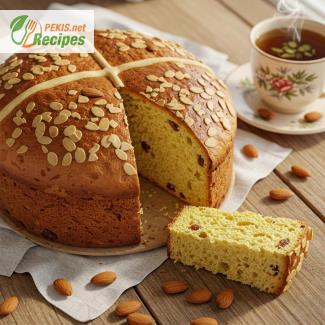
A Taste of Czech Easter Traditions in Every Slice
Discover the sweet, almond-kissed delight that brings families together during spring holidays
Czech Mazanec, also known as Bohemian Easter bread, is a cherished symbol of springtime celebration in the Czech Republic. With its golden crust, subtly sweet crumb, and the unmistakable aroma of almonds and citrus zest, Mazanec has been a centerpiece of the Easter table for generations. This traditional sweet bread captures the essence of Czech heritage—rooted in simplicity, enhanced by flavor, and passed from one family to another with love.
Unlike other festive breads, Mazanec blends the richness of butter and eggs with the lightness of lemon and rum-soaked raisins, creating a delicate balance between indulgence and rustic comfort. Its signature cross on top, often brushed with egg wash and sprinkled with slivered almonds, is not only symbolic of the season’s religious roots but also adds a satisfying crunch and visual charm to the loaf.
For many Czechs, Easter would not be complete without the scent of freshly baked Mazanec filling the kitchen. Typically prepared on Holy Saturday and enjoyed on Easter Sunday morning, this bread is a delicious reminder of renewal, togetherness, and tradition. Whether sliced thick and served with butter, or enjoyed on its own with a cup of tea, Mazanec is a culinary emblem of warmth and celebration.
The origins and symbolism of Mazanec
The roots of Mazanec date back to the Middle Ages, where it was often baked by monks to mark the end of the Lenten fast. The bread’s round shape and scored cross represent resurrection and new life, which align with Easter’s spiritual themes. Over time, this bread evolved from a monastic staple into a beloved household recipe, enriched with family variations and passed down through oral tradition.
The Czech countryside is especially known for guarding the authenticity of this recipe. In smaller villages, grandmothers bake Mazanec from scratch, using regional ingredients and closely held secrets to perfect the flavor and texture. Many households still follow the ritual of preparing the dough early in the morning, allowing it to rise slowly while church bells echo across the valleys.
A harmony of flavors in every bite
What sets Czech Mazanec apart is its refined combination of ingredients. While similar in appearance to other festive loaves like Italian Panettone or Slovak Paska, Mazanec boasts a distinctly Czech profile. The use of rum-soaked raisins, lemon zest, and almond slivers infuses the bread with a fragrance that evokes both comfort and festivity. The interior is light and airy, but with a satisfying moistness that comes from quality dairy and carefully timed baking.
Every bite brings a burst of brightness from the citrus, a mellow depth from the rum, and a nutty crunch from the almonds. The overall sweetness is understated—just enough to call it dessert-worthy, but still subtle enough to pair with savory dishes or breakfast spreads.
Perfect for Easter and beyond
Though traditionally baked for Easter, Mazanec’s appeal extends well beyond the holiday. It’s the kind of bread you’ll want to bake again for Sunday brunch, spring picnics, or even as a thoughtful homemade gift. Served warm with a touch of honey, or toasted and topped with fresh cheese, it transitions beautifully into various meals and moments.
Its longevity is another benefit. Thanks to its enriched dough and subtle sweetness, Mazanec stays moist for days, especially when stored properly. This makes it an ideal make-ahead recipe, perfect for busy holiday preparations or simply to enjoy the comforting aroma of home baking throughout the week.
A beloved centerpiece of Czech family life
In Czech homes, baking Mazanec is more than a recipe—it's a seasonal ritual and a celebration of heritage. Children often help shape the dough or sprinkle the almonds, creating family memories as rich as the bread itself. The shared experience of kneading, baking, and finally enjoying the bread together is what makes Mazanec so special.
As you slice into its golden crust, you’re not just tasting a delicacy—you’re embracing a story of faith, family, and festive tradition. Whether you’re reviving childhood memories or discovering Czech baking for the first time, Mazanec is the perfect way to honor the season with something deliciously meaningful.
- Soak the raisins in dark rum for at least 1 hour, or overnight if possible. Drain before adding to the dough.
- Warm the milk to lukewarm (not hot). Add a teaspoon of the sugar and stir in the yeast. Let sit for 10–15 minutes until frothy.
- In a large bowl, combine flour, sugar, and salt. Add lemon zest and slivered almonds (reserve a few for topping).
- In another bowl, whisk together egg yolks, whole egg, and vanilla extract. Add this to the dry ingredients along with the frothy yeast mixture and softened butter.
- Mix until the dough begins to form, then knead by hand or with a mixer for about 10 minutes until smooth and elastic.
- Gently knead in the soaked raisins, making sure they are evenly distributed.
- Cover the bowl with a clean towel and let the dough rise in a warm place for about 90 minutes, or until doubled in size.
- Once risen, turn the dough out onto a lightly floured surface. Shape it into a round loaf.
- Place on a parchment-lined baking sheet. Cover loosely and let rise again for 45 minutes.
- Preheat the oven to 170°C (340°F).
- Brush the loaf with beaten egg and score a cross on the top using a sharp knife. Sprinkle with reserved slivered almonds.
- Bake for 40–45 minutes, or until golden brown and a skewer inserted into the center comes out clean.
- Let cool on a wire rack. Dust with powdered sugar once cooled, if desired.
Elevating the Classic Mazanec: Creative Enhancements and Healthy Twists
Discover how thoughtful ingredient swaps and baking techniques can transform your Easter bread
The traditional Czech Mazanec is already a beloved Easter staple, but even time-honored recipes offer opportunities for refinement. With a few carefully considered modifications, home bakers can elevate this festive bread to suit modern tastes, dietary preferences, and even improve its nutritional profile—all while preserving its authentic charm. Whether you’re baking for the first time or seeking to add a personal touch, understanding the science behind the ingredients, common pitfalls, and substitution strategies can help you craft a loaf that stands out for both its flavor and presentation.
Enhancing flavor through ingredient upgrades
One of the simplest ways to upgrade your Mazanec is by using high-quality ingredients that naturally intensify the flavor. Instead of basic raisins, try using golden sultanas, dried cranberries, or even finely chopped dried apricots soaked in dark rum or orange liqueur. These alternatives add complexity and a subtle tartness that balances the bread’s sweetness.
Adding a touch of orange zest alongside the traditional lemon zest will introduce a richer citrus note. For a spiced variation, consider incorporating a pinch of ground cardamom, cinnamon, or even grated nutmeg. These spices complement the bread’s buttery profile and offer a warm, festive aroma.
Another tip is to toast the slivered almonds before adding them to the dough or as a topping. Toasted nuts develop deeper flavors and add an extra layer of crunch. You could also experiment with chopped hazelnuts or pistachios for a gourmet touch.
Common mistakes and how to avoid them
Even experienced bakers can fall into traps when preparing enriched breads like Mazanec. One of the most common issues is overproofing the dough, which can cause it to collapse or bake unevenly. To avoid this, keep a close eye on the dough’s rise—it should double in size but not exceed that. Use the finger dent test to check readiness: gently press a finger into the dough. If the dent springs back slowly, it’s ready. If it collapses completely, it may be overproofed.
Another frequent mistake is using cold ingredients, especially butter and eggs. All dairy and eggs should be at room temperature to ensure proper emulsification and a smooth, elastic dough. Cold butter can inhibit the rise and prevent proper gluten development.
Many bakers also skip the second proofing stage, which is essential for achieving a light, fluffy crumb. Be patient—giving the shaped loaf time to rise again ensures an even texture and beautiful oven spring.
Homemade Mazanec vs. store-bought: why it matters
While you can find pre-made Mazanec in some stores or bakeries, homemade versions are far superior in flavor, texture, and nutritional quality. Baking from scratch allows for control over every ingredient, avoiding unnecessary preservatives, additives, or artificial flavors commonly found in commercial varieties.
The act of baking at home also creates a stronger emotional connection with the food. It becomes more than a recipe—it’s an experience, a memory in the making. Your kitchen fills with the aroma of sweet dough, citrus, and toasted nuts, bringing the spirit of Easter to life. Plus, you can adjust the sweetness level or add your favorite flavors for a truly customized creation.
Health-conscious alternatives that don’t sacrifice taste
If you’re looking to make your Mazanec a bit healthier, several substitutions can maintain the bread’s integrity while improving its nutritional profile. Swap a portion of the all-purpose flour with whole wheat flour—try using a 3:1 ratio to avoid a dense result. Whole wheat flour adds fiber, vitamins, and a slightly nutty flavor.
Instead of using only butter, consider replacing half with Greek yogurt or mashed banana to reduce saturated fat and increase moisture. For a dairy-free version, coconut oil or plant-based butter are excellent options, adding their own subtle richness.
When it comes to sweeteners, replacing granulated sugar with honey, maple syrup, or coconut sugar can offer a more complex sweetness and lower glycemic index. Just be mindful of the moisture content—if using liquid sweeteners, reduce the milk slightly.
For an egg-free version, each egg can be replaced with 60 ml (¼ cup) applesauce, flaxseed meal mixed with water, or commercial egg substitutes. These replacements maintain structure and moisture without compromising flavor.
Small techniques that make a big difference
Improving Mazanec isn’t just about ingredients—it’s about mastering technique. One tip is to allow the dough a slow, cold rise overnight in the refrigerator. This retards fermentation, resulting in deeper flavor development and a more elastic crumb.
Another key element is proper scoring. The cross on top is more than a symbolic gesture; it allows the dough to expand evenly in the oven, preventing unsightly cracks. Use a sharp, oiled blade or bread lame to make clean, deep slashes.
Brushing the loaf with egg wash twice—once before the final proof and again just before baking—gives the crust a deep golden sheen and helps the almonds adhere firmly.
Making it your own: regional and creative variations
Although traditional Mazanec is shaped round, you can experiment with different presentations. Try shaping the dough into a braided loaf or baking it in a Bundt pan for a visually striking centerpiece. For added flair, incorporate a swirl of poppy seed paste or nut filling into the center, much like other Central European pastries.
You can also adapt the recipe with seasonal ingredients—fresh cranberries in autumn, candied citrus in winter, or even dried lavender for a spring twist. These additions bring a new layer of elegance and keep the tradition alive in a fresh, contemporary way.
Želiš, da nadaljujem z različicami recepta za bolj zdravo Mazanec ali za posebne prehranske potrebe?
- Contains: gluten (wheat flour), eggs, milk (butter), tree nuts (almonds)
- May contain: alcohol (rum)
Substitution tips: - Gluten-free: Use a 1:1 gluten-free flour blend with xanthan gum.
- Egg-free: Replace each egg with 60 ml (¼ cup) applesauce or a commercial egg replacer.
- Dairy-free: Use plant-based butter.
- Nut-free: Omit almonds or replace with toasted pumpkin seeds.
- Vitamin A: 120 µg – Supports vision and immunity
- Vitamin B1 (Thiamine): 0.3 mg – Boosts energy metabolism
- Vitamin D: 0.8 µg – Contributes to calcium absorption
- Calcium: 40 mg – Essential for bone health
- Iron: 1.8 mg – Vital for oxygen transport
- Magnesium: 20 mg – Supports muscle and nerve function
- Zinc: 0.7 mg – Enhances immune system
- Flavonoids (from lemon zest and almonds): 30 mg – Help reduce inflammation
- Vitamin E (from almonds and butter): 2 mg – Protects cells from oxidative damage
- Polyphenols (from raisins): 25 mg – May support heart health and digestion





